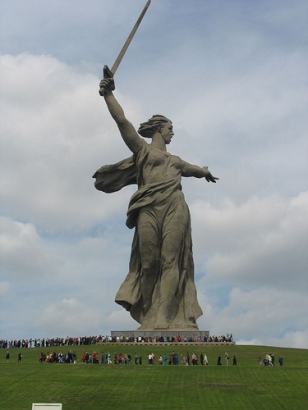

Mamayev Kurgan or "tumulus of Mamai" holds a dominant height overlooking Volgograd. It is situated on the right bank of the Volga River. This small piece of land became the key to securing the city during bloody battle of Stalingrad.

Mamayev Kurgan or "tumulus of Mamai" holds a dominant height overlooking Volgograd. It is situated on the right bank of the Volga River. This small piece of land became the key to securing the city during bloody battle of Stalingrad.
Mamayev Kurgan is a Tartar (Mongol tribe) burial mound at a height of 102 meters. This location in general has many legends and stories. Some are based on facts, others are hard to prove. It is known that Sarmatians regarded this area as sacred and carried out religious rituals here as early as 5th century BC. Some even believe that military expedition of Persian king Darius against these nomadic tribe might have reached area of modern day Volgograd. Another legend claim that after the battle at Kulikovo Field in 1380 Tatar general Mamai fled the victorious Russian army to banks of Volga. Here he was killed by a contender to a throne of the Golden Horde and here Mamai was supposedly buried. Although we know now that it is not true "kurgan" or tumulus belonged to some unknown prominent Tatar leader.
During World War II Mamayev Kurgan became the central prize in Stalingrad Battle. Due to its dominant position in the city Germans threw thousands of troops and tanks to capture it. Soviet Red Army defended the hill for over 200 days. Over 35,000 of Soviet soldiers were buried at the conclusion of the grandiose battle. However until 1959 the mound was pitted with bombs and mines. From 1959 to October 1967 Mamayev Kurgan was turned into monument "Heroes of the Battle of Stalingrad" dedicated to soldiers who fell here. It encompasses a total area of 26 hectares.
Church of All Saints (Volgograd) |
Panorama Museum (Volgograd) |
History of the monument
In May 1959, under the
leadership of the sculptor E. V. Vuchetich, the construction of the
monument-ensemble "To the Heroes of the Battle of Stalingrad" began
on the Mamayev Kurgan.
On October 15, 1967, the grand opening
of the monument took place. The ceremony was attended by the General
Secretary of the Central Committee of the CPSU L.I.Brezhnev,
Minister of Defense of the USSR A.A.Grechko, Marshals of the Soviet
Union A.I. Eremenko, V.I. Chuikov.
The initial project
provided for the construction of the second stage of the ensemble -
from Lenin Avenue to the Volga. In 1968, by order of the regional
executive committee, a section from Lenin Avenue to the Volga edge
was allocated for these purposes. From Lenin Avenue to the Volga, a
pedestrian alley was to be located, steles with the names of all
units of the Soviet army that took part in the Battle of Stalingrad.
The monument-ensemble "To the Heroes of the Battle of
Stalingrad" on January 31, 2008 was included in the list of federal
monuments and since then has been in federal ownership. To transfer
it to the jurisdiction of Roskultura, it was combined with the
panoramic museum "Battle of Stalingrad". Alexander Velichkin, who
for many years headed the regional committee for culture, was
appointed director of the state institution.
On June 12,
2008, the results of the "7 Wonders of Russia" competition were
announced on Red Square in Moscow. According to the results of the
vote, Mamaev Kurgan was included in the list of seven Russian
miracles.
Since 2016, the action "Light of the Great Victory"
has been held on the Mamayev Kurgan - a light projection on the
monument "The Motherland Calls!" On the evening of Victory Day, at
the end of the festive events, a story about the heroes and battles
of the Great Patriotic War begins on the Mamayev Kurgan with
newsreels and light projection on the retaining wall and the main
monument. The action has become one of the recognizable business
cards not only of the monument-ensemble, but also of the city of
Volgograd.
In 2019, the Motherland Calls monument has been
restored.